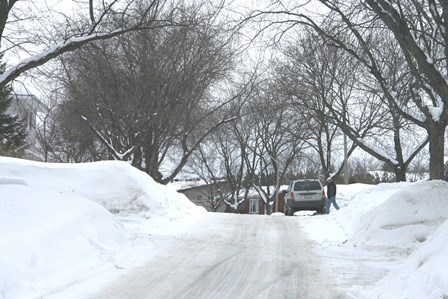While many in Sudbury grumble about having to deal with six-foot snowbanks on either side of their driveways, the city is struggling with another problem: keeping streets wide enough for two cars to safely pass one another.
Tony Cecutti, the city’s general manager of infrastructure services, said so much snow has fallen and stayed this winter, snow plows are running out of places to push it.
“When the snowbanks get so high, snow will start to roll down the bank again” after the plow goes by, Cecutti said Feb. 22. “And then the lane width of the road gets narrower.
“We do have some roadways where we have challenges keeping a proper lane width. So we will go back and remove enough snow to ensure that two cars can pass each other safely.”
In early winter, snow control largely involves pushing snow to the side of the road. But this time of year, crews not only have to deal with snowfall, but they have to remove or slice sections off of snowbanks so cars can safely pass each other.
“And the challenge this time of the year is that it often continues to snow,” Cecutti said. “Our first priority is always clearing the main arterial roads. We occasionally have to abandon our snow removal operations to go back to snow clearing.”
If there’s a significant snowfall, it will take a couple of days to clear the snow from city streets, he said. Their target is to plow all the roads within 24 hours, but they usually have to go back and clean up certain roads again, sidewalks, laneways, etc.
“And after all those things are done, we go back to snow removal operations again.”
The only area of the city where removing snowbanks is a priority is downtown, an area with heavy traffic and where sightlines become impaired once snowbanks reach one metre. In other parts of the city, the priority is maintaining sightlines at intersections.
“Maintaining the width of the road is the priority for us, but generally speaking, the height of the snowbank is not a criteria for us,” he said. “We don’t manage winter control by measuring heights of snowbanks. That’s not a criteria for us at all, except the downtown core.
“We don’t have the equipment or the resources to be picking up snow off of every snowbank. The cost of that would be prohibitively expensive. And there isn’t enough equipment in this town, through our forces or through contractors, to pick up all the snow from every snowbank in the city.”
And while road width is a priority, main arterial roads are done first, while side streets are put on a priority list to be done later. That means it will take a while to clear those streets, and people must drive carefully.
“Our expectation is that drivers will take it slower in those areas,” he said. “We always say, drive according to conditions, and this time of year, if it keeps snowing, conditions are going to get more challenging and people have to drive accordingly.”
It would help crews tremendously, Cecutti said, if residents stopped parking on city streets overnight, and stopped throwing snow from their property into the middle of the street. Both make it much harder to maintain a minimum road width.
“So we end up with some roads being more narrow than we would like, and it takes us time to get back there to redo them,” he said. “Most people are very respectful, but occasionally it happens. And then it makes it difficult for everybody.”
While they have received plenty of calls from people about the height of snowbanks, Cecutti said many people are just tired of winter.
“But the snow still keeps coming …We sympathize, and we’ll keep monitoring the width of the roadways and get at all the ones we can.”
One hopeful factor is, as March approaches, once there’s a few days of warmer weather, snowbanks on main arterial roads will melt quickly, because of the high salt content. But that won’t help residents living on side streets, because there’s only a bit of salt mixed in with the sand used on those roads.
Join Sudbury.com+
- Messages
- Post a Listing
- Your Listings
- Your Profile
- Your Subscriptions
- Your Likes
- Your Business
- Support Local News
- Payment History
Sudbury.com+ members
Already a +member?
Not a +member?
Sign up for a Sudbury.com+ account for instant access to upcoming contests, local offers, auctions and so much more.
